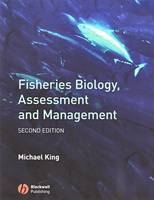
Fisheries Biology, Assessment and Management
Wiley-Blackwell (Verlag)
978-1-4051-5831-2 (ISBN)
Positive trends include actions being taken to decrease the incidental catches of non-target species, consumer preferences for seafood from sustainable fisheries, and the establishment of no-take areas that provide refuges for marine species. But there is an urgent need to do more.
Because there is an increasing recognition of the need to manage ecosystems as well as fish stocks, this second edition of this bestselling text book includes an additional chapter on marine ecology. Chapters on parameter estimation and stock assessment now include step-by-step instructions on building computer spreadsheet models, including simulations with random variations that realistically emulate the vagaries of nature. Sections on ecosystem management, co-management, community-based management and marine protected areas have been expanded to match the increased interest in these areas.
Containing many worked examples, computer programs and numerous high quality illustrations, Fisheries Biology, Assessment and Management, second edition, is a comprehensive and essential text for students worldwide studying fisheries, fish biology, aquatic and biological sciences. As well as serving as a core text for students, the book is a superb reference for fisheries and aquatic researchers, scientists and managers across the globe, in both temperate and tropical regions. Libraries in all universities where fish biology, fisheries, aquatic sciences and biological sciences are studied and taught will need copies of this most useful new edition on their shelves.
Supplementary material is available at: www.blackwellpublishing.com/king
Dr Michael King, Fisheries Consultant, Queensland, Australia
Contents. Preface.
Acknowledgements.
1 Ecology and ecosystems.
1.1 Introduction.
1.2 Distribution and abundance.
1.2.1 Unit stocks.
1.2.2 Spacing of organisms.
1.3 Population growth and regulation.
1.3.1 Population growth.
1.3.2 Population regulation.
1.3.3 Life history patterns.
1.4 Marine ecosystems.
1.4.1 Coastal waters.
1.4.2 Coral reefs and lagoons.
1.4.3 Continental shelves and the open sea.
1.5 Human impacts on marine ecosystems.
1.5.1 Habitat modification and loss.
1.5.2 Eutrophication, siltation and heat.
1.5.3 Petroleum, toxic chemicals and solid waste.
1.5.4 Species invasions, introductions, and translocations.
1.5.5 Climate change - the greenhouse effect and global warming.
1.5.6 Ozone depletion.
1.5.7 Assessing and minimizing environmental impacts.
1.6 Photosynthetic marine organisms.
1.6.1 Macroalgae - seaweed.
1.6.2 Microalgae - phytoplankton.
1.6.3 Harmful algal blooms.
1.7 The flow of energy and material.
1.7.1 Zooplankton.
1.7.2 Daily migrations and the seasonal distribution of plankton.
1.7.3 Food relationships, trophic levels and foodwebs.
1.8 Productivity and fisheries.
1.8.1 Primary productivity and yield.
1.8.2 Productivity from fisheries and aquaculture.
.
2 Exploited species.
2.1 Introduction.
2.2 Invertebrates.
2.2.1 Molluscs.
Bivalves - clams and cockles.
Gastropods - sea snails.
Cephalopods - squids and octopuses.
Management measures.
2.2.2 Crustaceans.
Penaeids and carideans - prawns and shrimps.
Nephropidae - clawed lobsters.
Palinuridae - slipper and spiny lobsters.
Brachyuran crabs.
Anomuran crabs.
Management measures.
2.2.3 Other invertebrates.
Holothurians - sea cucumbers.
Echinoids - sea urchins.
Management measures.
2.3 Fishes.
2.3.1 Demersal fishes of cooler waters - cods, hakes and haddocks.
2.3.2 Demersal and reef fishes of warmer waters.
2.3.3 Coastal pelagic fishes - clupeoids.
2.3.4 Offshore pelagic fishes - tunas and sharks.
2.3.5 Management measures.
3 Fishing and fishers.
3.1 Introduction.
3.2 Fishing gear and methods.
3.2.1 Gleaning, spears and traps.
3.2.2 Hooks and lines.
3.2.3 Stationary nets.
3.2.4 Towed nets and dredges.
3.3 Fishers.
3.3.1 Fishing for food.
3.3.2 Fishing for income.
3.3.3 Fishing for recreation.
3.4 Effects of fishing.
3.4.1 Effects on target species.
3.4.2 Effects on non-target species.
3.4.3 Effects on the environment and ecosystems.
.
4 Stock structure and abundance.
4.1 Introduction.
4.2 Structure and abundance.
4.2.1 Relative abundance.
4.2.2 Sampling surveys.
4.2.3 Mark-recapture methods.
4.2.4 Depletion methods.
4.3 Factors that increase biomass.
4.3.1 Size and growth.
4.3.2 Growth from length-frequency data.
4.3.3 Growth from tagging information.
4.3.4 Growth from hard-part analyses.
4.3.5 Reproduction.
4.3.6 Recruitment.
4.4 Factors that decrease biomass.
4.4.1 Age-based catch curves.
4.4.2 Length-based catch curves.
4.4.3 Mortality from mark-recapture data.
4.4.4 Natural mortality.
5 Stock assessment.
5.1 Introduction.
5.2 Stock abundance and catches - dynamic production models.
5.2.1 Equilibrium models.
5.2.2 Non-equilibrium models.
5.2.3 Multispecies applications.
5.2.4 Potential yield - rough estimators.
5.3 Including growth and mortality.
5.3.1 The effects of growth and mortality on biomass.
5.3.2 The effects of fishing mortality on a single cohort.
5.4 Including different year classes; age-structured models.
5.4.1 Virtual population analysis.
5.4.2 The classical yield per recruit model.
5.4.3 The Thompson and Bell model.
5.5 Simulation and ecosystem models.
5.5.1 A biomass dynamic simulation model.
5.5.2 An age-structured simulation model.
5.5.3 Ecosystem models.
5.5.4 Risk assessment.
6 Fisheries management.
6.1 Introduction.
6.2 The need for fisheries management.
6.2.1 Biological overfishing.
6.2.2 Economic overfishing.
6.3 Managers and stakeholders.
6.3.1 Fisheries management authorities.
6.3.2 Co-management in commercial fisheries.
6.3.3 Community-based fisheries management.
6.4 The management process.
6.4.1 Management policies and objectives.
6.4.3 Reference points and indicators.
6.4.4 Management plans.
6.5 Management actions.
6.5.1 Input controls (on fishing and fishing effort).
Limiting the number of fishing units.
Limiting the efficiency and types of fishing gear.
Minimum mesh sizes and escape gaps.
6.5.2 Output controls (on the catch).
Quotas.
Size limits.
Rejection of females or gravid females.
6.5.3 Controls to protect the ecosystem.
Closures as fisheries management tools.
6.5.4 Compliance and enforcement.
References.
Appendices.
1. Fisheries symbols and formulae.
2. Standard deviation and confidence limits.
3. Correlation and regression.
4. Least squares.
5. Collection of length-frequency data.
6. Bhattacharya plots.
7. Statistical tables.
Glossary of terms.
Index
| Erscheint lt. Verlag | 22.8.2007 |
|---|---|
| Verlagsort | Hoboken |
| Sprache | englisch |
| Maße | 191 x 246 mm |
| Gewicht | 966 g |
| Themenwelt | Naturwissenschaften ► Biologie ► Limnologie / Meeresbiologie |
| Naturwissenschaften ► Biologie ► Ökologie / Naturschutz | |
| Weitere Fachgebiete ► Land- / Forstwirtschaft / Fischerei | |
| ISBN-10 | 1-4051-5831-X / 140515831X |
| ISBN-13 | 978-1-4051-5831-2 / 9781405158312 |
| Zustand | Neuware |
| Haben Sie eine Frage zum Produkt? |
aus dem Bereich


